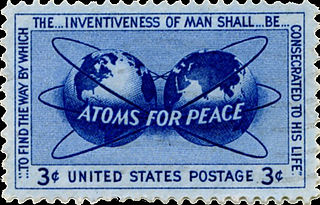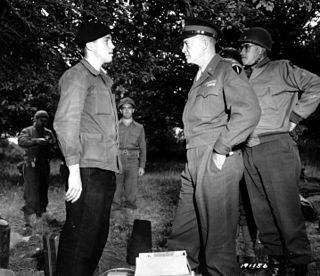
Dwight David Eisenhower, nicknamed Ike, was an American military officer and statesman who served as the 34th president of the United States from 1953 to 1961. During World War II, he was Supreme Commander of the Allied Expeditionary Force in Europe and achieved the five-star rank as General of the Army. Eisenhower planned and supervised two of the most consequential military campaigns of World War II: Operation Torch in the North Africa campaign in 1942–1943 and the invasion of Normandy in 1944.

Gettysburg is a borough in and the county seat of Adams County, Pennsylvania, United States. As of the 2020 census, the borough had a population of 7,106 people.
The expression military–industrial complex (MIC) describes the relationship between a country's military and the defense industry that supplies it, seen together as a vested interest which influences public policy. A driving factor behind the relationship between the military and the defense-minded corporations is that both sides benefit—one side from obtaining weapons, and the other from being paid to supply them. The term is most often used in reference to the system behind the armed forces of the United States, where the relationship is most prevalent due to close links among defense contractors, the Pentagon, and politicians. The expression gained popularity after a warning of the relationship's detrimental effects, in the farewell address of U.S. President Dwight D. Eisenhower on January 17, 1961.

On 1 May 1960, a United States U-2 spy plane was shot down by the Soviet Air Defence Forces while conducting photographic aerial reconnaissance deep inside Soviet territory. Flown by American pilot Francis Gary Powers, the aircraft had taken off from Peshawar, Pakistan, and crashed near Sverdlovsk, after being hit by a surface-to-air missile. Powers parachuted to the ground and was captured.

Thomas Sovereign Gates Jr. was an American politician and diplomat who served as Secretary of Defense from 1959 to 1961 and Secretary of the Navy from 1957 to 1959, both under President Dwight D. Eisenhower. During his tenure as Secretary of Defense, he established a task force to set nuclear target priorities. He also authorized U-2 reconnaissance flights, including the flight of Francis Gary Powers.

The 1958 United States House of Representatives elections was an election for the United States House of Representatives to elect members to serve in the 86th United States Congress. They were held for the most part on November 4, 1958, in the middle of Dwight Eisenhower's second presidential term, while Maine held theirs on September 8. There were 436 seats during these elections: 435 from the reapportionment in accordance with the 1950 census, and one seat for Alaska, the new state that would officially join the union on January 3, 1959.

The Civil Rights Act of 1960 is a United States federal law that established federal inspection of local voter registration polls and introduced penalties for anyone who obstructed someone's attempt to register to vote. It dealt primarily with discriminatory laws and practices in the segregated South, by which African Americans and Mexican-American Texans had been effectively disenfranchised since the late 19th and start of the 20th century. This was the fifth Civil Rights Act to be enacted in United States history. Over an 85-year period, it was preceded only by the Civil Rights Act of 1957, whose shortcomings largely influenced its creation. This law served to more effectively enforce what was set forth in the 1957 act through eliminating certain loopholes in it, and to establish additional provisions. Aside from addressing voting rights, the Civil Rights Act of 1960 also imposed criminal penalties for obstruction of court orders to limit resistance to the Supreme Court's school desegregation decisions, arranged for free education for military members' children, and banned the act of fleeing to avoid prosecution for property damage. The Civil Rights Act of 1960 was signed into law by President Dwight D. Eisenhower.

"Atoms for Peace" was the title of a speech delivered by U.S. President Dwight D. Eisenhower to the UN General Assembly in New York City on December 8, 1953.
I feel impelled to speak today in a language that in a sense is new—one which I, who have spent so much of my life in the military profession, would have preferred never to use. That new language is the language of atomic warfare.

The New Look was the name given to the national security policy of the United States during the administration of President Dwight D. Eisenhower. It reflected Eisenhower's concern for balancing the Cold War military commitments of the United States with the nation's financial resources. The policy emphasised reliance on strategic nuclear weapons as well as a reorganisation of conventional forces in an effort to deter potential threats, both conventional and nuclear, from the Eastern Bloc of nations headed by the Soviet Union.

Dwight D. Eisenhower's tenure as the 34th president of the United States began with his first inauguration on January 20, 1953, and ended on January 20, 1961. Eisenhower, a Republican from Kansas, took office following his landslide victory over Democratic nominee Adlai Stevenson in the 1952 presidential election. Four years later, in the 1956 presidential election, he defeated Stevenson again, to win re-election in a larger landslide. Eisenhower was limited to two terms and was succeeded by Democrat John F. Kennedy, who won the 1960 presidential election.

The Dwight D. Eisenhower School for National Security and Resource Strategy, formerly known as the Industrial College of the Armed Forces (ICAF), is a part of the National Defense University. It was renamed on September 6, 2012, in honor of Dwight D. Eisenhower who graduated from this school when it was previously known as the Army Industrial College.

The second inauguration of Dwight D. Eisenhower as president of the United States was held privately on Sunday, January 20, 1957, at the White House and publicly on the following day, Monday, January 21, 1957, at the East Portico of the United States Capitol; both located in Washington, D.C. This was the 43rd inauguration and marked the commencement of the second and final four-year term of both Dwight D. Eisenhower as president and Richard Nixon as vice president. Chief Justice Earl Warren administered the presidential oath of office after the Senate Minority Leader William Knowland swore in the vice president.

The first inauguration of Dwight D. Eisenhower as the 34th president of the United States was held on Tuesday, January 20, 1953, at the East Portico of the United States Capitol in Washington, D.C. This was the 42nd inauguration and marked the commencement of the first term of Dwight D. Eisenhower as president and of Richard Nixon as vice president. Chief Justice Fred M. Vinson administered the presidential oath of office to Eisenhower. The vice presidential oath was administered to Nixon by Senator William Knowland.

Eisenhower's farewell address was the final public speech of Dwight D. Eisenhower as the 34th President of the United States, delivered in a television broadcast on January 17, 1961. Perhaps best known for advocating that the nation guard against the potential influence of the military–industrial complex, a term he is credited with coining, the speech also expressed concerns about planning for the future and the dangers of massive spending, especially deficit spending, the prospect of the domination of science through federal funding and, conversely, the domination of science-based public policy by what he called a "scientific-technological elite". This speech and Eisenhower's Chance for Peace speech have been called the "bookends" of his administration.
The 1955 State of the Union Address was given by the 34th president of the United States, Dwight D. Eisenhower, on Thursday, January 6, 1955, to the 84th United States Congress. He said, "Every citizen wants to give full expression to his God-given talents and abilities and to have the recognition and respect accorded under our religious and political traditions." He also said, "To protect our nations and our peoples from the catastrophe of a "nuclear holocaust", free nations must maintain countervailing military power to persuade the Communists of the futility of seeking their ends through aggression." He is referring to what seemed to be the high likelihood of nuclear warfare of the time. He ended with, "And so, I know with all my heart--and I deeply believe that all Americans know--that, despite the anxieties of this divided world, our faith, and the cause in which we all believe, will surely prevail." This address was given in his first term (1953-1957), in Washington, D.C.
The 1956 State of the Union Address was given by Dwight D. Eisenhower, the 34th president of the United States, on Friday, January 5, 1956, to both houses of the 84th United States Congress. He said this in it, "There has been broad progress in fostering the energies of our people, in providing greater opportunity for the satisfaction of their needs, and in fulfilling their demands for the strength and security of the Republic."
The presidency of Dwight D. Eisenhower began on January 20, 1953, when Dwight D. Eisenhower was inaugurated as the 34th president of the United States, and ended on January 20, 1961.
The United States foreign policy of the Dwight D. Eisenhower administration, from 1953 to 1961, focused on the Cold War with the Soviet Union and its satellites. The United States built up a stockpile of nuclear weapons and nuclear delivery systems to deter military threats and save money while cutting back on expensive Army combat units. A major uprising broke out in Hungary in 1956; the Eisenhower administration did not become directly involved, but condemned the military invasion by the Soviet Union. Eisenhower sought to reach a nuclear test ban treaty with the Soviet Union, but following the 1960 U-2 incident the Kremlin canceled a scheduled summit in Paris.

The "People of Western Europe" speech was made by Supreme Commander of the Allied Expeditionary Force General Dwight D. Eisenhower in the run-up to the invasion of Normandy in 1944. Addressed to the people of occupied Europe it informed them of the start of the invasion and advised them on the actions Eisenhower wanted them to take. It also addressed the Allies' plans for post-liberation government.

The presidential transition of John F. Kennedy began when he won the 1960 United States presidential election, becoming the president-elect of the United States, and ended when Kennedy was inaugurated at noon EST on January 20, 1961.













